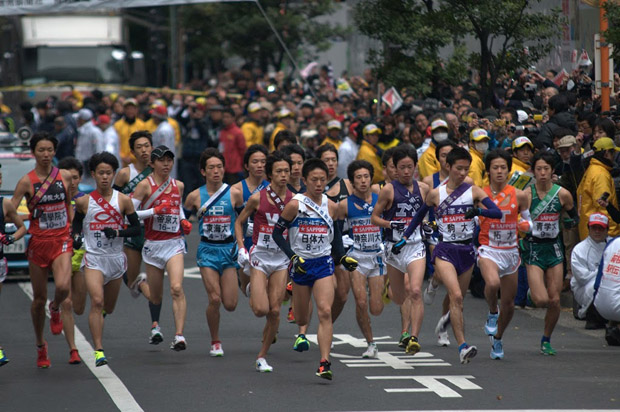Feature: Running – Big in Japan
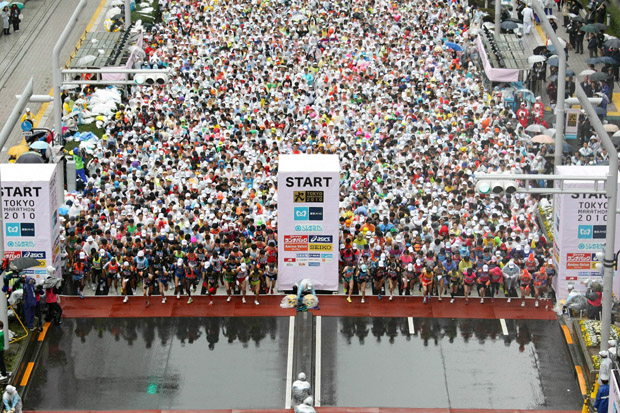
By Andrea Seccafien
Running is the biggest sport in Japan. Races are broadcast live and in prime time and they garner the biggest ratings on TV. It seems that everyone runs in Japan. Andrea Seccafien went there to find out why.
The Imperial Palace in Tokyo sees an average of 4,000 recreational runners a day training for the marathon outside the Emperor of Japan’s residence. The mass moves in single file in a counter-clockwise direction, respecting the needed etiquette of the loop.
These runners are a part of the Japanese running boom, with domestic races selling out faster than anywhere else on earth. But this phenomenon is surprisingly new in a country that has long been obsessed with running.
In stark contrast to the West’s long tradition of participation and marginal interest in watching competitive running as entertainment, Japan has only recently embraced recreational running. But distance running, and the marathon in particular, has a strong history as a significant spectator sport on the island country.
“The Japanese are good runners,” says Kevin Curnock, a recreational Runner who lived in Japan for a two-year period in the early 2000s. “There was a strong culture of competitive running, but a decade ago there wasn’t really a culture of Recreational running.” All that has changed in a big way in just a few short years.

Japanese marathoners have enjoyed success on the world stage since the early 1900s, which fuelled national pride for the sport. This popularity comes from the reliability of the characteristics that are needed to succeed at the marathon. These attributes parallel those often considered part of Japanese society: discipline, austerity, self lessness and inner-strength.
Not only that but the Japanese appreciate a good foot race. And they get to see it. There are live broadcasts of domestic races almost every weekend through September to March from high school track meets to professional marathons. With this exposure to races, distance runners are treated as celebrities in Japan and children aspire to be like them. Yuki Kawauchi, the “citizen runner,” with a full-time job and five marathon victories from 2013, has become a folk hero and has further expanded spectatorship at domestic road races.
Marathon running culture in Japan is changing. The longtime spectator sport of marathoning has spread beyond the elite and the serious amateur to become one of mass participation. There has always been a large population of amateur runners in Japan. While dedicated Western runners might target qualifying for the Boston Marathon, their Japanese equivalents are going for Fukuoka’s across-the-board 2:40 standard, Beppu-Oita’s 2:50, or the Nagoya, Osaka and Yokohama Women’s Marathons, which require all entrants run at least 3:15 to gain entry. While these races have traditionally privileged elite runners, there’s now more of a trend towards the introduction of mass participation marathons in Japan.
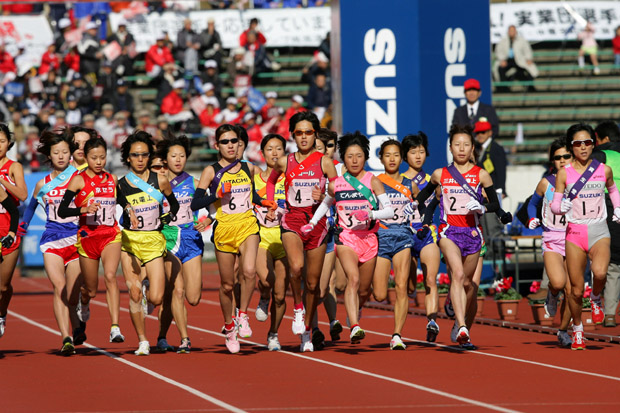
The Honolulu Marathon has long been the destination for recreational runners who want to experience a marathon. Last year 13,000 Japanese runners made the trip to Hawaii, making up half the marathon field. But with the launch of the Tokyo Marathon in 2007, Japanese runners are now able to race at home, if they’re lucky. The Tokyo Marathon is limited to 35,500 participants. Last year they received 303,450 applications, forcing the race organizers to use a lottery to select its field.
With 10 per cent of entries allotted to international racers, Japanese runners have only a 10 per cent chance of acceptance, making it one of the hardest races in the world to enter.
The Tokyo Marathon race directors are hoping to increase the number of participants to 40,000, which would make Tokyo one of the three largest marathons in the world. Along with participation numbers, the Tokyo Marathon has a well-earned reputation as an event with great spectators, with upwards of two million people showing up to cheer on the runners.
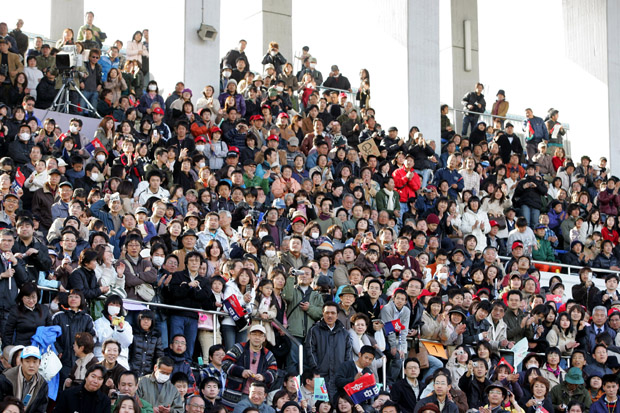
As a result of the Tokyo Marathon, other long standing, elite-only races have shifted away from that format and have incorporated a more popular, mass participation event in the age of the big-city marathon. New marathons are springing up in Japan as well, including the Saga Sakura Marathon in April, a Kitakyushu race in 2014 and one in Okayama in 2015.
These new races have contributed to the 240 per cent increase in the annual number of runners who completed domestic marathons over the last five years in running-crazy Japan. Previous to the mass participation races being introduced in Japan, the marathon was seen as a race run by elites only and the Japanese excelled at it.
Japan’s consistent depth on the road has the rest of the world wondering what makes this small country so dominant in the longer distances. Boasting several Olympic and World Championship medallists in the marathon, Japan is rivalled only by Kenya and Ethiopia on the world stage.
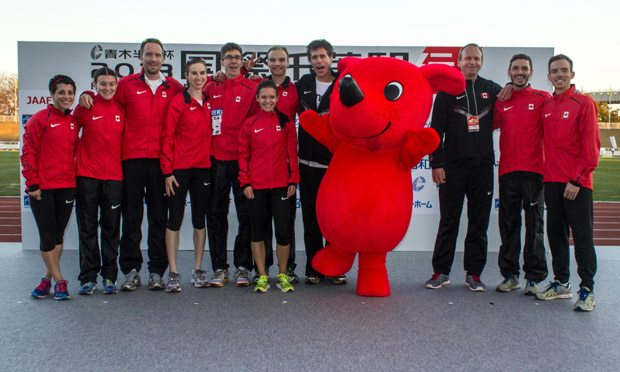
The International Chiba Ekiden is an annual marathon relay race held in Chiba, a city of about one million, 40 kilometres southeast of Tokyo, every November. Ekidens can be any distance and any number of legs. This particular one is the marathon distance of 42.195 kilometres and has six legs run by three men and three women. The women race distances of 7.2k or 5k and the men race 5k or 10k. A sash, called a tasuki, is passed between team members, like a baton in a track relay. Ekidens are based around the importance of an individual runner within a group and everyone giving their best effort to benefit the team. While cross-country runners may understand the team aspect of long distance running, Japanese runners hold a profound responsibility and obligation to their team. They race head-to-head in the stages with each leg being a race in and of itself, but the end goal is to deliver for the group.
Ekidens make up a season of their own and the enthusiasm for the competition is akin to the nhl hockey playoffs. “Ekidens were often on television,” Curnock recalls. “The college championship was a big deal, and would be broadcast at bars and restaurants as a big event.”
“What makes the Ekiden great entertainment is that it provides a larger context for running,” says Brett Larner, a Canadian living in Japan who manages the popular running blog, Japan Running News. “Watch a regular race and most of the time you will only see a few people going head-to head or one runner time trialling. Even a serious fan might watch a race once or twice, but there’s no overall story there, no drama or plot.” Ekidens fill this void.
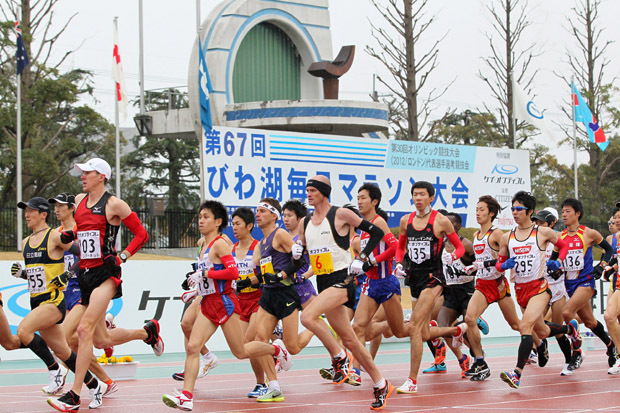
The individual legs provide a compelling and dramatic event, captivating a nation of viewers. The Hakone Ekiden, the most prominent university ekiden, has the largest television broadcast of anything in Japan and attracts a 30 per cent viewership. The popularity of the sport can be seen in race numbers, but also through the hyper-organization and generosity of race directors. The Chiba directors treat the participating athletes like royalty. The teams from every country are flown in, fed, accommodated and given an allowance of spending money courtesy of the race organizers.
On the day of the 2013 race, the city of Chiba buzzed with excitement. Spectators lined the roads and cheered for every country as if it was their own. Those at home enjoyed a full, live broadcast of the event with the breakdown of statistics on the athletes and the performances of the previous year, insuring the presence of a knowledgeable and engaged audience.
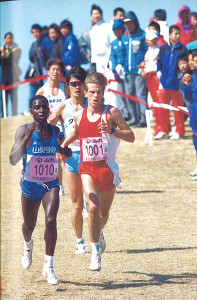 “Pretty much anywhere in Japan, if you stopped the first person on the street and asked them how long the marathon is, they would immediately answer 42.195k,” says Larner. “They could even go on to tell you who Naoko Takahashi (the women’s gold medallist in the 2000 Olympic marathon) or Toshihiko Seko (a winner of Boston, London and Chicago in the 1980s) are and what they’ve accomplished.”
“Pretty much anywhere in Japan, if you stopped the first person on the street and asked them how long the marathon is, they would immediately answer 42.195k,” says Larner. “They could even go on to tell you who Naoko Takahashi (the women’s gold medallist in the 2000 Olympic marathon) or Toshihiko Seko (a winner of Boston, London and Chicago in the 1980s) are and what they’ve accomplished.”
Much like Canadian kids play out scenes of scoring a Stanley Cup-winning goal, grade schoolers in Japan fantasize about breaking the tape at the Olympic marathon. From a young age, their training is geared towards making the jump to the big distance as seamless as possible. Unlike in North America, high school-aged athletes first focus on the 5,000m or 10,000m, and very few will run shorter distances as they do in the West.
Adding to the popularity of road racing is the support of corporations that fund track clubs to field a team in the corporate national ekiden championships, the New Year Ekiden. This came out of the recovery of the Japanese economy after the Second World War. Corporations began to spend money on sports teams as a morale builder, allowing amateur sport to fall under the budget of private industries. Now, nearly every type of company has a stake in the road racing scene. Automakers, insurance companies, cosmetic makers, banks and department stores are just a few of the types of business that support a corporate team.
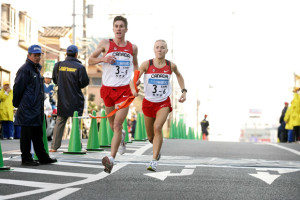 These corporate teams are similar to professional sports teams in North America. Corporations provide their runners with salaries, housing, meals and a full-time staff of coaches and therapists. In return, the athletes represent the corporation in races, providing advertising as well as building a corporate team spirit. “The purpose of a team is to unite the workers in supporting their company through the camaraderie of cheering for their own team,” Larner explains.
These corporate teams are similar to professional sports teams in North America. Corporations provide their runners with salaries, housing, meals and a full-time staff of coaches and therapists. In return, the athletes represent the corporation in races, providing advertising as well as building a corporate team spirit. “The purpose of a team is to unite the workers in supporting their company through the camaraderie of cheering for their own team,” Larner explains.
Jeff Schiebler was just 21 years old when he first came to Japan. The native of New Westminister, B.C. was recruited after winning the Canadian cross-country championships in 1996. The national title landed him an invitation to a Japanese cross-country race, which he won as well. Japanese recruitment agents took interest in him for a corporate team.
In 1996, there weren’t many opportunities to race professionally in Canada, so Schiebler went to Japan, thinking that he would try it out for a year. The one-year experiment turned into calling Japan home for nine years. During that time, he competed for two Japanese computer electronics companies, NEC and Fujitsu. These companies, along with the Canadian elite athlete funding system and a Nike endorsement, allowed Schiebler to live a comfortable life as a professional athlete and to train full-time, an opportunity that remains rare for even the best Canadian runners today. In 2001, it was reported that Schiebler was making a six-figure salary as a runner in Japan.
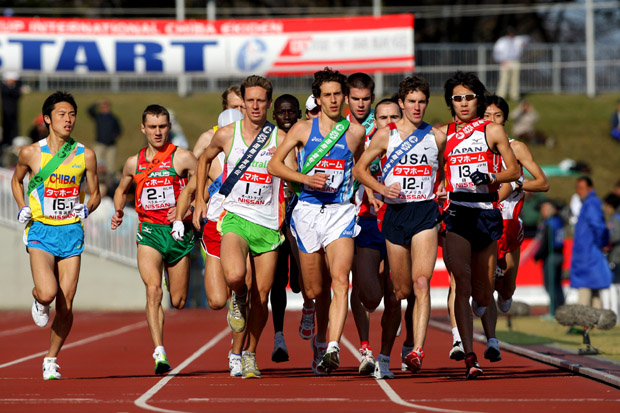
Being part of a corporate team allows runners to train two to three times per day and freely attend training camps year round. Japanese training in general is heavily geared towards developing marathon runners with long, slow distance as the cornerstone of their training. The athletes on Shiebler’s corporate team would run as much as 280k a week, the equivalent of a marathon a day. This type of training was in line with a general Japanese outlook that an athlete doesn’t have to be the fastest runner, they just have to do the work and eventually the results will show.
With ekidens being the main focus of the corporate teams, the coaching and training is geared towards improving the depth of the team overall, rather than nurturing a standout athlete. Runners would do their training runs or workouts at the pace of the slowest runner, to improve the group together. Schiebler recalls, “If someone got injured or couldn’t run on the day of an ekiden, the corporation would have 10 to 15 runners that would be able to run around the same level.
With the corporate system supporting the elite runners and churning out impressive marathoners year after year to race the ekidens, and mass participation races popping up around the country, the running boom in Japan doesn’t seem to be slowing down any time soon. In fact, it seems it has only just begun. “When you get down to it, the Japanese have a great love and appreciation for all facets of the sport that remains unmatched,” Larner says.
